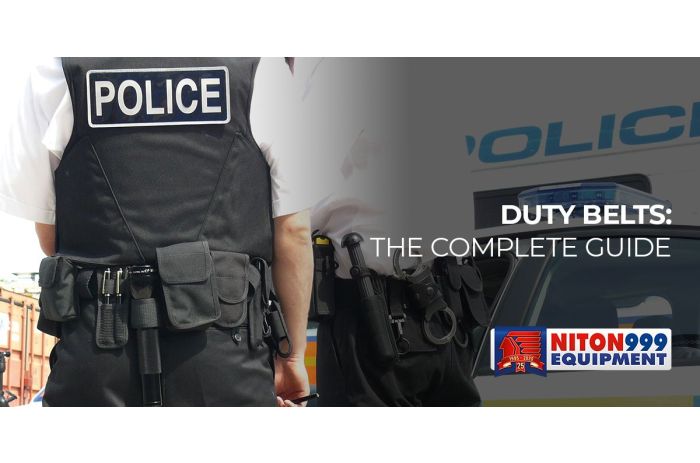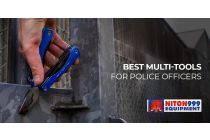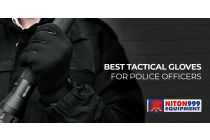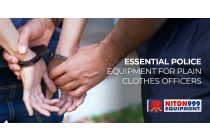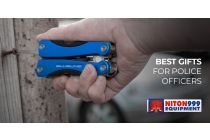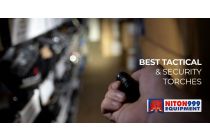Duty belts are an essential piece of equipment for law enforcement officers, security personnel, and other professionals who need to carry multiple items on their person while performing their duties.
While simple in characteristic and design, the duty belt is an essential piece of kit that delivers support while carrying essential equipment.
Here’s everything you need to know about the humble duty belt.
Key Components of a Police Duty Belt in the UK
So, what is a duty belt and what are the key components? In simple terms, a police duty belt is a critical piece of equipment that allows an officer to carry various tools necessary for daily activities and emergencies.
The layout and components of a duty belt can vary depending on the officer's role, environmental conditions and personal preferences.
However, there are some standard items that most police officers will carry on their duty belts.
Handcuff Case
The handcuff case is typically positioned for easy, quick access.
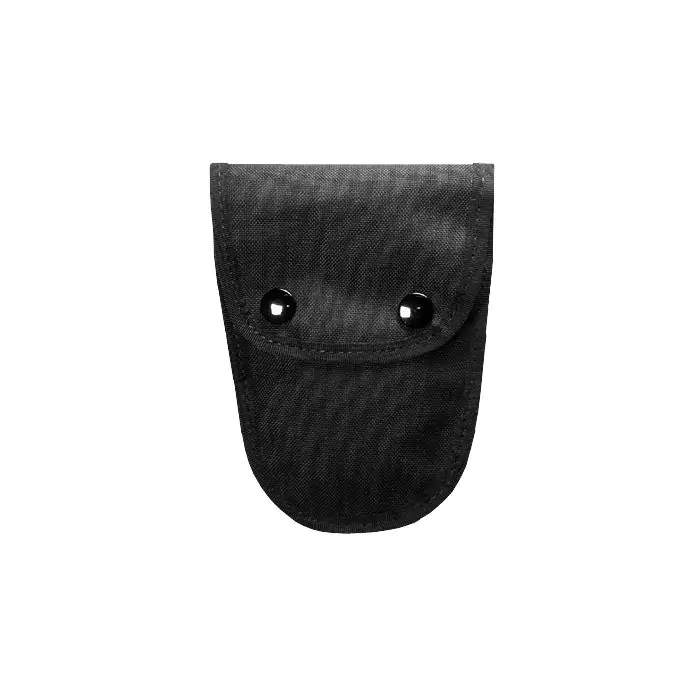
Above: Standard nylon handcuff pouch
Handcuffs are vital for restraining suspects and are one of the most commonly used tools by police officers.
Advantages:
- Quick accessibility
- Provides secure and durable storage for handcuffs
Disadvantages:
- Takes up valuable real estate on a limited-space duty belt
Baton Holder
The baton holder keeps the expandable baton, an essential tool for self-defence and control, within reach but secure.
The baton can be quickly deployed in situations requiring non-lethal force.
Advantages:
- Holds the baton securely but allows for quick retrieval
- Often designed to allow one-handed deployment of the baton
Disadvantages:
- May be bulky
- Placement on the belt can affect comfort and mobility
Firearm Holster
For officers authorised to carry firearms, a secure and easily accessible holster is an indispensable component of their duty belt.
The holster must ensure that the firearm is both secure and quickly accessible.
Advantages:
- Provides quick access to a firearm when needed
- Usually equipped with retention systems to prevent unauthorised removal
Disadvantages:
- Takes up a considerable amount of space on the duty belt
- Weight of the firearm can be a concern for long-term comfort
Radio Pouch
Communication is vital in policing, and the radio pouch holds the communication radio securely in place.
It’s generally positioned so that the radio can be easily accessed with either hand. Radios may also be attached to the best.
Advantages:
- Keeps the radio secure but easily accessible
- Allows for hands-free carrying of an essential communication tool
Disadvantages:
- May be cumbersome depending on the size of the radio
- Can interfere with other equipment if not properly positioned
Torch Holder
Low-light situations are commonplace in policing, and a torch is essential for safety. The torch holder ensures that the flashlight is readily available when needed.
Advantages:
- Quick and easy access to a flashlight
- Securely holds the flashlight in place, preventing loss or accidental activation
Disadvantages:
- Flashlights vary in size, requiring different holder sizes
- Takes up additional space on the duty belt
Miscellaneous Pouches
Police officer belt setups often require an array of miscellaneous pouches. These are used for carrying various other items such as notebooks, multi-tools, gloves, or first aid kits.
They are often customisable based on the officer's role and the specific needs of their duties.
Advantages:
- Versatile and can be customised to carry a variety of tools
- Can be positioned based on personal preference and accessibility
Disadvantages:
- Can add bulk and weight to the duty belt
- Too many pouches can make the belt cumbersome and less functional
Police Belt Buckle
The buckle is a crucial but often overlooked component. It's vital for fastening the belt and is often designed to prevent accidental or unauthorised release.
Advantages:
- Provides a secure fit for the entire duty belt system
- Some models have quick-release features for emergencies
Disadvantages:
- Incorrectly fastened buckles can lead to equipment loss or malfunctions
- Must be compatible with the specific duty belt used
Material
Regarding the material of a police utility belt, you generally have two main options: nylon and leather. Nylon is durable, lightweight, and relatively inexpensive.
It's also easier to clean, making it a practical choice for everyday use. On the downside, nylon may not offer the same polished look as leather and can be less rigid, affecting the stability of holsters and pouches.
Conversely, leather offers a classic and professional appearance and provides a rigid structure that can securely hold equipment.
However, leather is heavier, often more expensive, and requires regular maintenance to keep it in top condition.
Weight Distribution
A well-designed utility belt should distribute the weight of your equipment evenly around your waist.
Even weight distribution minimises the risk of back strain and allows for quicker and more agile movement, essential factors for police officers who may find themselves in fast-developing, high-intensity situations.
Poorly designed belts that don't distribute weight evenly can lead to chronic pain over time and may also slow down an officer's reaction time.
Size and Adjustability
The size of your utility belt matters a lot. A belt that's too tight will be uncomfortable and can impede movement, while a belt that's too loose could lead to equipment falling off or being hard to reach.
The belt should be adjustable to fit comfortably around your waist even when fully loaded with equipment.
Accessibility
Accessibility is another important factor. You'll need to be able to quickly and easily reach all of your tools and equipment.
Whether it's your handcuffs, firearm, or radio, each piece should have its own designated spot on your belt where it's both secure and easily accessible.
Popular Brands
Choosing a well-known and respected brand can save you time and hassle in the long run, as you're more likely to get a high-quality product with a proven track record.
Blauer
Blauer is known for its durable and functional designs. The brand offers various utility belts suitable for various police duties.
With a focus on durability and functionality, Blauer is a go-to for many law enforcement professionals.
Niton 999
Niton 999 offers a broad range of products, including various types of holsters and belt accessories. Niton 999 products deliver quality at excellent prices.
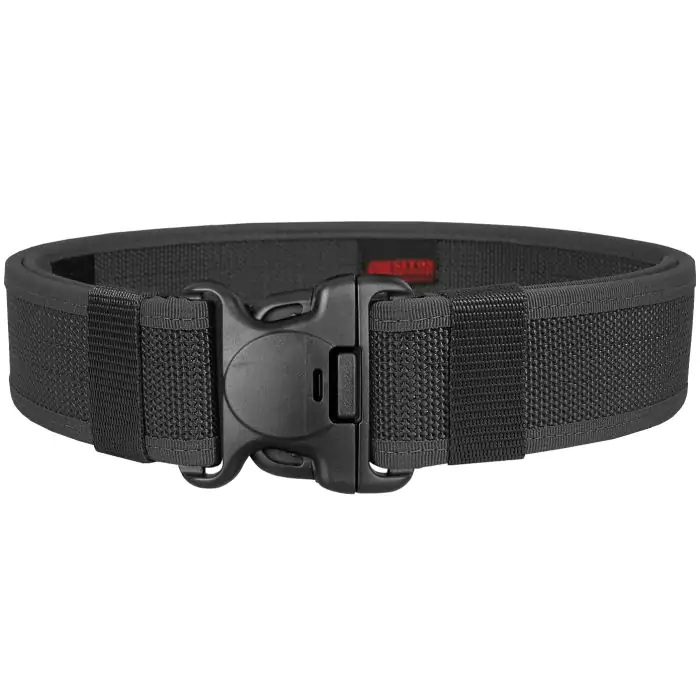
Above: the Niton 999 Duty Belt
Blackhawk
Blackhawk is particularly well-known for high-quality nylon belts. The brand offers utility belts that are durable, lightweight, and designed for optimal weight distribution.
Bianchi
Bianchi is a brand to consider if you're looking for a more traditional leather belt. Known for their leather designs, they offer stylish and functional belts, although often at a higher price point.
Tips on Setting Up a Duty Belt in the UK
Setting up a duty belt may seem simple, but the arrangement can significantly impact an officer's performance and comfort on the job.
The equipment should be placed strategically for easy access and to avoid any unnecessary strain during long duty hours. Here are some tips to consider when setting up a police duty belt.
Prioritise Essentials
It's crucial to have quick access to essential items like your firearm, handcuffs, and radio. These should be placed within easy reach of your dominant hand.
Most officers place their service weapon on the strong-side hip and handcuffs on the opposite side for balance.
The idea is to have these life-saving tools at your fingertips, ready to be drawn instantly if needed.
Balance
A well-balanced belt distributes the weight of your equipment evenly across your hips, reducing the strain on your lower back and making it easier to move quickly when necessary.
This is especially important during high-stress scenarios, where a poorly balanced belt could impede your mobility and effectiveness.
Accessibility
Not only should essential items be easy to reach, but all items should be accessible using either hand.
This is important for situations where one hand might be occupied or incapacitated. Make sure to periodically test your setup by reaching for each item with both hands to ensure accessibility.
Regular Adjustments
Your duty belt isn't a "set it and forget it" piece of equipment.
Over time, as your role evolves or your set of equipment grows, it's essential to make regular adjustments.
Summary
Duty belts are vital pieces of policing gear, designed to provide support while carrying vital pieces of equipment like radio pouches and baton holders.
While the duty belt is fundamentally simple, it serves a key purpose and should be set up so all equipment is easily accessible.
Niton999 stocks a range of excellent duty belts here, including our own superb value Niton999 Duty Belt.
FAQs
How to Wear a Duty Belt
Wearing a duty belt effectively is about more than just putting it around your waist. The belt should be snug but not too tight, allowing for full range of motion.
The duty belt is often worn over another belt, known as a "trouser belt," which goes through the belt loops of the uniform pants. This setup helps to provide additional stability and keeps the duty belt in place.
What Equipment Can Be Carried
The list of items on a police duty belt can vary depending on the officer's role, the department's regulations, and the specific challenges of a given assignment. However, common items usually include:
- Handcuffs
- Baton or other impact weapon
- Service firearm
- Communication radio
- Flashlight
- Pouches for gloves, notebooks, and sometimes first-aid items
- Additional ammunition
Each department might have its own regulations about what can or should be carried out, so it's essential to be familiar with these guidelines.

